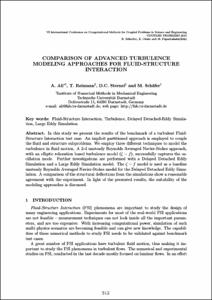Comparison of advanced turbulence modeling approaches for fluid-structure interaction

Visualitza/Obre
Estadístiques de LA Referencia / Recolecta
Inclou dades d'ús des de 2022
Cita com:
hdl:2117/191196
Tipus de documentText en actes de congrés
Data publicació2015
EditorCIMNE
Condicions d'accésAccés obert
Tots els drets reservats. Aquesta obra està protegida pels drets de propietat intel·lectual i
industrial corresponents. Sense perjudici de les exempcions legals existents, queda prohibida la seva
reproducció, distribució, comunicació pública o transformació sense l'autorització del titular dels drets
Abstract
In this study we present the results of the benchmark of a turbulent FluidStructure Interaction test case. An implicit partitioned approach is employed to couple the fluid and structure subproblems. We employ three different techniques to model the turbulence in fluid motion. A 2-d unsteady Reynolds Averaged Navier-Stokes approach, with an elliptic relaxation based turbulence model (ζ −f), successfully captures the oscillation mode. Further investigations are performed with a Delayed Detached Eddy Simulation and a Large Eddy Simulation model. The ζ −f model is used as a baseline unsteady Reynolds Averaged Navier-Stokes model for the Delayed Detached Eddy Simulation. A comparison of the structural deflections from the simulations show a reasonable agreement with the experiment. In light of the presented results, the suitability of the modeling approaches is discussed.
ISBN978-84-943928-3-2
| Fitxers | Descripció | Mida | Format | Visualitza |
|---|---|---|---|---|
| Coupled-2015_44-Comparison of advanced.pdf | 1010,Kb | Visualitza/Obre |

